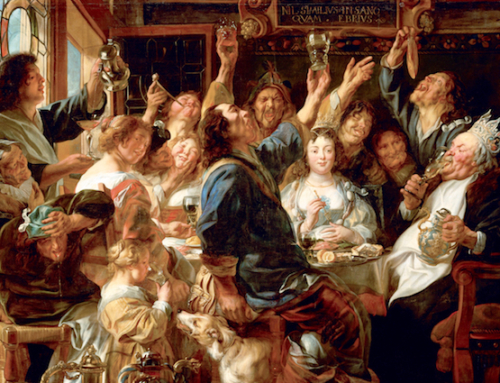It might be too early to say, but the present recoil from fake news might prove that we are not quite ready to abandon the values we once thought so completely debunked. Truth might still stand a chance…
 Over the last few months, a number of publications have been running articles about what may be called the earlier history of fake news. “History is littered with examples where the facts were altered to suit a specific purpose,” reads a recent story from the Scientific American. It is claimed that the fake news phenomenon associated with Trump’s election is only a recent development of something with roots that reach farther and deeper.
Over the last few months, a number of publications have been running articles about what may be called the earlier history of fake news. “History is littered with examples where the facts were altered to suit a specific purpose,” reads a recent story from the Scientific American. It is claimed that the fake news phenomenon associated with Trump’s election is only a recent development of something with roots that reach farther and deeper.
Yet, it is hard to be sure that this recent trend has a history. Leaving aside fake news for a moment, a distinction should be made between two types of misleading information: one is personal defamation (defamatory texts or word-of-mouth gossip, such as person X is epithet Y because of reason Z, Z being optional); the other is conspiracy theories (the truth about mainstream X is gnostic Y, believe us). Both have long histories, the highlights of which are outlined in these recent articles. Not any defamatory remark is fake news, however, just as not any piece of fake news would be conspiracy material. Saying that Donald Trump is a crook because of a number of arguments (or none at all) is not the same as publicizing that he actually did or say something which simply did not happen. Similarly, few would think that the story about Fox News’ Megan Kelly getting fired over endorsing Hillary Clinton would be part of a conspiracy. What the two types have in common, however, is the fact that the “information” put forward is factually inaccurate and designed to deceive, for whatever reason.
Fake news, however, is a different beast for at least two reasons. One has to do with diffusion, the other with reception. Fake news is more treacherous than both classic defamatory texts and conspiracy pieces in that the source of the fake stories is not instantly recognized as problematic and dubious. Sometimes it is not even known. The fake story may come from anywhere, and when it is traced back to an original source, it may not always be easy to prove guilt by association. When CNN and Buzzfeed were involved in promoting the story about the alleged relations between President Trump and Russia, a media ethics sandstorm ensued, an expression of general concern over how credible media sources can avoid telling fake news from genuine material. Protean and elusive, fake news has the ability to change hands under the cover of media darkness. Whilst conspiracy texts usually have an easily traceable source, fake news stories seem to emerge out of nowhere, or they are produced by media outlets not previously known to be dealing in this commodity. Standard defamatory texts are admittedly similar, but they are quite easy to detect. Their usual virulence gives away both source and intent. As such, they are hardly news stories. Hardline left-wing and right-wing publications are usually masters of this art. Fake news is casual, aptly crafted to inflict damage and multiply without drawing too much attention to itself.
Reception, however, is more important in describing the singularity of fake news. It also helps explain the reason why the fake news phenomenon has actually emerged only recently. It is worth asking why there is the widespread feeling (surely not fake) that fake news came into its own over the last few years.
Fake news could not have emerged at any other point in history. It is a phenomenon that depends on the fluidity of social media streams and the role these play in our lives. A condition of the emergence of fake news may be what Walter Ong has called, “secondary orality,” and Thomas Pettitt, more recently, “the Gutenberg parenthesis.” Both concepts refer to the impact of social media on our Enlightenment-based textual practices. The modern view of stable, single-authorial text is being undermined by social practices incubated and shaped by social media. The stability of texts is eroded by a kind of “oralized” textuality. Facebook posts, comments, and tweets are certainly text, but they share a lot with verbal communication–structural instability, mass dissemination, evanescence. As authors become less important, the flux of comments or open-ended additions assumes the function of authorship, destabilizing the original text. Fake news is like that. Once it starts, it cannot be stopped and is resistant to that authorial genealogy which would allow it to be recognized for what it is. Fake news is a product of the digital age.
That is not to say that the lack of clear authorship makes the strength of fake news stories. It merely confounds our textual expectations. On the other hand, because fake news emerges in and develops through social media networks, reception is key. It is what makes fake news so redoubtable. It impacts more people than any other piece of deceptive news at any other point in history. The web resounds with stories about stories that reach millions of people in a matter of hours. We are also more concerned about fake news than about embarrassing false rumors because it affects structures of power previously thought impervious to its earlier, similar embodiments. Fake news is all about politics. It should not surprise us that we see the emergence of the fake news phenomenon around one of the most controversial presidential elections in decades.
Fake news also raises questions about our understanding of truth more generally. Since at least the 1960s, truth as the epistemological arch-concept has been as eroded in philosophy as pre-social-media textuality has been in our online channels of written communication. Truth has been relativized, deconstructed, reconstructed, and misconstructed, with the effect that its ontological, moral, religious, or aesthetic applications have ceased to be binding. They now elicit mere indifference, if not suspicion, from many of us. It seems to me that truth has survived only as a notion of scientific accuracy or factuality. Because of this repli sur soi, truth is now defended either as a category of science or out of a nostalgic, even romantic urge to recover a place of stability, a rock amidst shifting sands.
It is because of what the Italian philosopher Gianni Vattimo has called ‘pensiero debole’ (weak thought) that the Kantian notion of truth has suffered the double impact of fragmentation and diminution. Daniel Dennett has recently bemoaned the devastation postmodernism has caused to our modern epistemological notions. Outside science, there are only truths in the plural now, each privately claimed. Under this dispensation, fake news is no more fake than the corroborated report of three eyewitnesses. Yet, everywhere people seem to come to the rescue of “true” news, or truth more generally. The newly coined term “post-truth” bears witness to this sociological shift. Does this mean that we have become wary of the “predicament of Western modernity,” as Charles Taylor once famously put it? Have the depths of truthlessness been fathomed and found terrifying? Has fake news exposed the wasteland lying beyond our postmodern pastures? It might be too early to say, but the present recoil from fake news might prove that we are not quite ready to abandon the values we once thought so completely debunked. Truth might still stand a chance.
Books on the topic of this essay may be found in The Imaginative Conservative Bookstore. The Imaginative Conservative applies the principle of appreciation to the discussion of culture and politics—we approach dialogue with magnanimity rather than with mere civility. Will you help us remain a refreshing oasis in the increasingly contentious arena of modern discourse? Please consider donating now.







Enjoyed the article. I had friends at Harvard tell me multiple times that there is no such thing as objective truth, no ‘fact of the matter’ (to which I inevitably reply with either, “is that true?” or “does this table exist?” – I have yet to receive an answer). It is encouraging to see that there are convictions and concerns confounding this not-so-thorough pronouncement – we may work our minds up into Gordian knots, but our intuitions and values are still there to cut us free.
Fake news is a subset of misinformation, disinformation, propaganda or call it what you will. It has a long history; think serpent in the garden. Fake news certainly has the implication of intentional deception (by omission or commission) for some purpose. One Mr. A. Hitler in Chapter VI of his “Mein Kampf” details the best tried and true methodology of propaganda. He states the target: “It must be addressed always and exclusively to the masses.” Today social media and internet allow anyone/everyone in the masses a platform to absorb and express anything with a complete absence of reality or verification to a frequently gullible mass social audience. Remember the masses can vote.
An important difference today is that a functional propaganda minister is augmented by celebrities, wanna-be’s, and all kinds of others.
Even the Comments or Reviews of products or services are unreliable since unfortunately there are incentives, both pro and con, for false statements.
The individual today must work hard to ascertain true facts and a perspective concerning those facts.
Good luck and happy hunting.